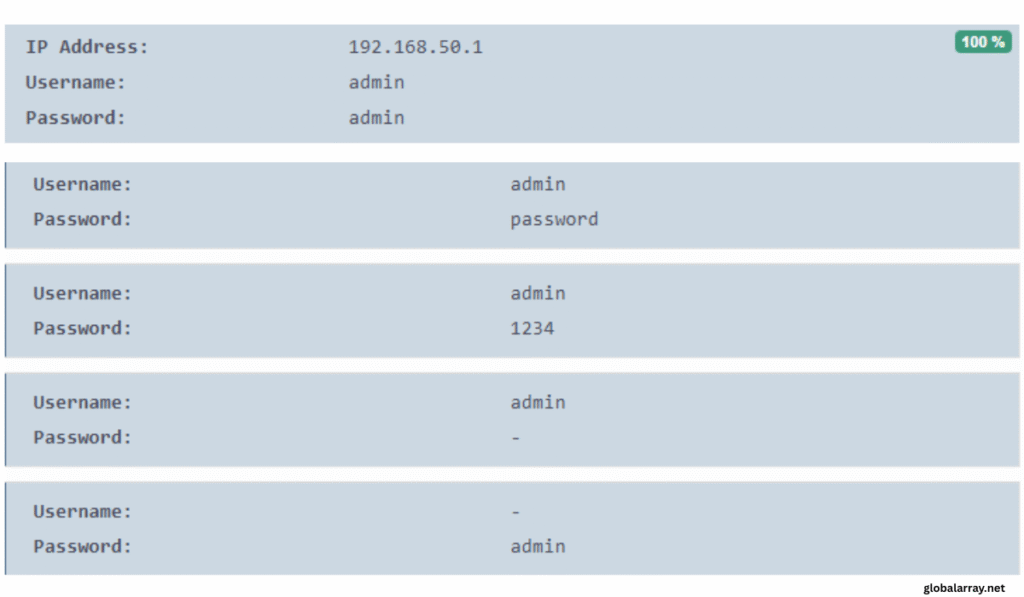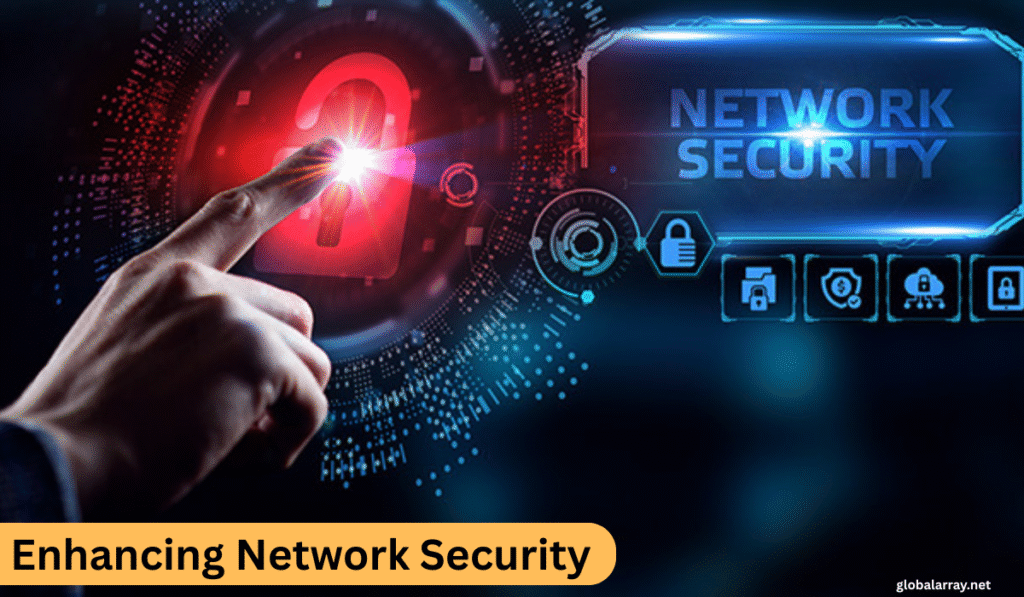192.168.50.1 is an IP address used to open the settings page of many home and small office routers. It helps you log in to your router so you can change things like your Wi-Fi name, password, and security settingsIn this guide, you’ll learn how to easily access your router using 192.168.50.1, fix common problems when logging in, and change important settings to keep your internet safe and working well. This guide is made for everyone, whether you’re new or already know a bit about routers.
Explain what 192.168.50.1 is and its role as a private IP address.
The router gives each device a number so they can connect and communicate. When you type 192.168.50.1 in your web browser, you open the router’s control page. From there, you can change your Wi-Fi name, set a password, and manage your network’s security.This IP address is used to keep your network safe and private from the internet.
Discuss its common usage in home routers, particularly with brands like ASUS and Sweex
Many router brands, such as ASUS and Sweex, use 192.168.50.1 as the default address for their routers. When you set up these routers, you can type this address in your browser to open the settings page.
On this page, you can change your Wi-Fi name and password, set up a guest network, and control other settings easily. You can also update the router’s software to make it work better and add new features.That is why 192.168.50.1 is popular—it gives users a simple way to control their routers without needing the internet.
Accessing Your Router via 192.168.50.1
Accessing Your Router via 192.168.50.1 means connecting to your router’s control panel through this special web address. By typing it into a browser while connected to your home network, you can open the router settings to manage your Wi-Fi and security options easily.
Connect to the router via Ethernet or Wi-Fi
Before you can access your router’s settings using the address 192.168.50.1, you need to make sure your device is connected to the router. You can connect your computer, laptop, or smartphone either using a wired Ethernet cable or through Wi-Fi.
| Connection Method | Description | When to Use | Important Tips |
| Ethernet (Wired) | Uses a physical LAN cable to connect your device directly to the router. | Best for stable and secure login to the router. | Plug the cable firmly into the LAN port and your device. |
| Wi-Fi (Wireless) | Connects your device to the router through the wireless signal it broadcasts. | Useful if a cable isn’t available or for mobile devices. | Make sure you’re connected to the correct Wi-Fi network provided by the router. |
Open a web browser and enter 192.168.50.1
Next, open any web browser on your device. This could be Chrome, Firefox, Safari, Edge, or any other browser you like to use. At the very top of the browser window, you will see the address bar. Click inside the bar, type 192.168.50.1, and then press the Enter key. If you have entered the address correctly and your device is connected to the router, you will be taken to the router’s login page. This page is where you can manage and change your router’s settings.
Input default login credentials (commonly ‘admin’ for both username and password)
When you see the login screen, it will ask you to enter a username and password. If this is your first time logging in or if the router has been reset to factory settings, you need to use the default login details. Most routers use admin for both the username and the password by default. These default details allow you to access the router’s admin panel for the first time.

Default credentials are often found on a sticker on the router
If you don’t know the username and password, don’t worry. Most routers have a sticker either on the back or on the bottom side. This sticker shows important information like the default IP address (usually 192.168.50.1), the default username, and the default password. Always check this sticker first before trying to reset your router or search online for the login details. Using the right default information helps you avoid problems logging in.
Also Read Our Article: 192.168.50.57 How to Login, Setup & Fix Router Issues
Troubleshooting Access Issues
Accessing your router’s admin page through 192.168.50.1 should be a quick and easy process but sometimes things don’t go as planned. If you’re having trouble, don’t worry. This guide will walk you through all the possible problems and how to fix them step by step. Whether it’s a typo, browser issue, or something else, the solutions below are designed to help you get back on track.
Incorrect IP address entry
Sometimes, users accidentally type the wrong IP address into the browser. A common mistake is typing 192.168.l.50.1, where the number “1” is replaced with a lowercase “L”, or using a different IP like 192.168.0.1. These are simple typos, but they will prevent you from reaching your router’s settings page. Always double-check that you have typed 192.168.50.1 correctly in the address bar—no extra dots or letters.
Forgotten login credentials
If you’ve logged in before and changed the default username or password, but now can’t remember the new ones, you’ll be locked out. In this case, you’ll need to reset the router. Almost all routers have a tiny reset button on the back or bottom. Press and hold this button with a paperclip or pin for 10 to 15 seconds. This will bring the router back to factory settings, including the original username and password (usually “admin” / “admin”).
Browser compatibility issues
Your web browser can also cause access problems. If you’re using an outdated browser or if you have a lot of browser extensions installed, they might block the router page from loading properly. To fix this, try switching to another browser (like Chrome, Firefox, Edge) or turn off any active extensions. Then reload the IP address to see if the login page appears.
Verify the router’s IP address using ‘ipconfig’ command
If you’re not sure whether 192.168.50.1 is actually your router’s IP address, you can confirm it using a simple command on your Windows computer. Open the Command Prompt by pressing the Windows + R keys, type cmd, and press Enter. In the black window that opens, type ipconfig and press Enter again. Look under the section that says Default Gateway. If it shows 192.168.50.1, then that’s the correct IP address to use in your browser.
Reset the router to factory settings if necessary
If nothing else works and you still can’t get to the login page, it’s time to reset your router. This can fix many issues, especially if the settings have been changed or if the software is stuck. Look for a small reset hole or button on the router. Hold it down with a pin for 10 to 15 seconds until the lights on the router blink. This will clear all custom settings and restore access with the default credentials.
Ensure the device is connected to the correct network
Make sure your computer, laptop, or phone is connected to the same network that the router is providing. If you’re on mobile data or a different Wi-Fi network, you won’t be able to reach 192.168.50.1. Double-check your connection and switch to the router’s Wi-Fi, or use an Ethernet cable for a stable connection.
Configuring Router Settings Post-Login
After you log in to your router using 192.168.50.1, you can change many important settings. These settings help you make your network safer and easier to use. Let’s look at some main things you can do after logging in.
Change Wi-Fi network name (SSID) and password
The Wi-Fi name, also called SSID, is what you see when you look for Wi-Fi networks on your phone or computer. Changing this name to something you like helps you find your network easily, especially if many networks are nearby. It’s also very important to set a strong password for your Wi-Fi. A strong password stops others from using your internet without your permission. Use a mix of letters, numbers, and symbols, and avoid easy or common words.
Update router firmware for improved performance
The router works with a small program called firmware. This program sometimes gets updates from the company to fix problems or make it safer and faster. It’s important to keep this software up to date so your internet works well and stays safe. You can find the update option in the router’s settings under “Administration” or “System.” When an update is available, follow the steps to install it.
Set up guest networks and parental controls
Many routers let you make a guest Wi-Fi network. This is a separate Wi-Fi for visitors so they can use the internet without seeing your private files or devices. You can give guests a different password and change it anytime. You can also set parental controls to keep kids safe online. These controls can block bad websites, limit how long kids use the internet, or stop them from visiting unsafe sites. This way, you protect your family while still letting them enjoy the internet.
Enhancing Network Security

Keeping your home internet safe is very important. After logging into your router using 192.168.50.1, you can do some easy steps to make your network more secure.
Change default login credentials
Most routers come with simple default usernames and passwords like “admin” and “admin.” These are easy for others to guess and can let hackers get into your router. It’s important to change these to a strong and unique password. A good password uses a mix of letters, numbers, and symbols. Changing your login details helps stop people from taking control of your internet without your permission.
Enable WPA2 or WPA3 encryption
Encryption protects the information sent between your devices and the router. The safest types right now are called WPA2 and WPA3. These keep your data safe so others can’t read it. Older types like WEP are not safe anymore and should not be used. Using WPA2 or WPA3 helps keep your Wi-Fi private and secure.
Disable WPS and remote management features
WPS (Wi-Fi Protected Setup) lets you connect devices easily without typing a password by pressing a button or entering a PIN. But WPS has security problems that hackers can use to get into your Wi-Fi. It’s better to turn off WPS.
Remote management lets you change your router settings from outside your home. While this can be useful, it can also let hackers try to get in. If you don’t need it, it’s safer to turn off this feature.
Set up a firewall or MAC address filtering
A firewall watches over your network and blocks unsafe or unwanted access. Most routers have a firewall you can turn on to help keep your network safe.
MAC address filtering lets you create a list of devices allowed to use your Wi-Fi. Each device has a unique ID called a MAC address. Only devices on the list can connect. This stops strangers from using your Wi-Fi.
Also Read Our Article: How to Use 172.30.1.1 for Home and Office Networks
Conclusion
To finish, logging into your router using 192.168.50.1 helps you control your home internet. You can change your Wi-Fi name and password, update your router’s software, and set up things like guest access or controls for kids. These changes make your internet safer and work better.
It is very important to keep your router’s software up to date. Updates fix problems and stop new risks. Checking for and installing updates often helps keep your network safe from hackers. Also, always use strong and different passwords for your Wi-Fi and router login. Easy or default passwords make it simple for others to break in.
FAQS
How do I change my 192.168 101.1 password?
Connect to the router’s network. Open a browser, type 192.168.101.1, and log in. Go to Wi-Fi settings, enter a new strong password, and save the changes.
What is the 192.168 0.1 password for Wi-Fi?
The default password for 192.168.0.1 depends on the router brand. Usually, it is “admin” or “password.” Check the router’s sticker for exact details or reset the router if lost.
How do I find my 192.168 10.1 password?
Look for the password on the router’s label. If forgotten, press the reset button for 10-15 seconds to restore default username and password printed on the router.
What does the IP address 192.168 100.1 belong to?
192.168.100.1 is a private IP address used by some routers or modems to let users access settings and manage their home network safely.
How to check Wi-Fi password?
On Windows, go to Network Settings, open Wi-Fi status, and check “Wireless Properties.” Under the Security tab, tick “Show characters” to see the saved Wi-Fi password.
Can I change Wi-Fi password?
Yes, you can. Log into your router using its IP address, go to Wi-Fi settings, enter a new password, save it, and reconnect devices with the updated password.
What is the 192.168 1.1 password change Wi-Fi password?
192.168.1.1 is a common router IP. Log in, access wireless settings, change your Wi-Fi password to something strong, save, and reconnect your devices with the new password.
How to change Wi-Fi password Bell?
Log into your Bell router via 192.168.2.1. Go to Wi-Fi settings, enter a new password, save changes, and reconnect devices using the new password to stay secure.
How to change Wi-Fi name and password Virgin?
Access your Virgin router at 192.168.0.1, log in, find Wi-Fi settings, change the network name (SSID) and password, save, and reconnect your devices to the updated network.
How to change Wi-Fi password from mobile?
Connect your phone to the router’s Wi-Fi. Open a browser, enter the router IP, log in, find Wi-Fi settings, change the password, save, and reconnect devices using the new password.
Should I change my Wi-Fi password?
Yes, change your Wi-Fi password regularly to keep your network safe from unauthorized users. Use a strong password and update it if you suspect others are using your connection.





